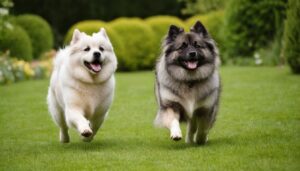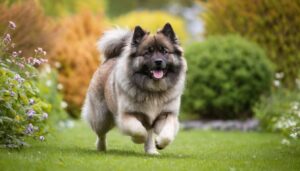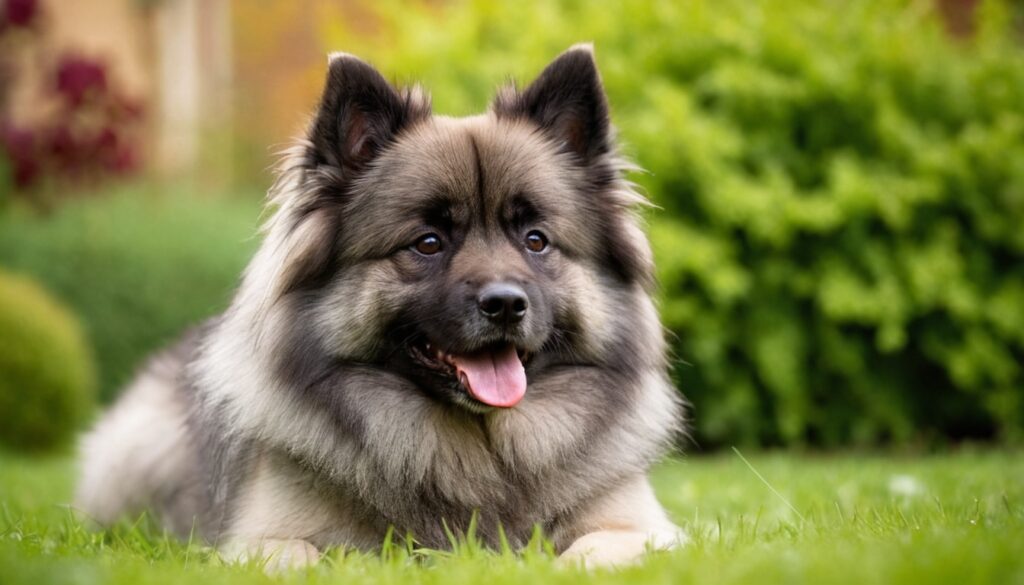In this article, we’ll cover everything about the Keeshond, including its history, appearance, temperament, grooming, training, health concerns, diet, and whether it’s the right dog for you.
The Keeshond (pronounce “KAYZ-hawnd”) is a medium-sized spitz-type dog with a dense, plush coat, fox-like head, and distinctive “spectacle” markings around the eyes. It is sometimes called the “Smiling Dutchman” because of its smiling and expressive face.
Originally bred as a bargeman’s guard on Dutch barges, the Keeshond is today loved for its loyal, loving, and smart nature. With or without a big house, this dog can easily fit into any home environment, provided that it is provided with love and care which it needs.
History and Origin of Keeshond
The Keeshond has a rich history rooted in the Netherlands. It was historically used as a watchdog on Dutch barges and farms, protecting property and keeping vermin under control.
The Dutch Patriot Symbol
In the 18th century, the Keeshond was used as the emblem of the Dutch Patriot Party, which was a political party opposing the ruling monarchy. The breed became linked to Cornelis (Kees) de Gyselaer, leader of the Patriots, and therefore called the Keeshond (Kees’ dog).
After the decline of the power of the Patriots, the breed was nearly extinct but was revived in the early 20th century in America and England. The Keeshond is currently recognized by big kennel clubs like the American Kennel Club (AKC) and is cherished as a faithful friend.
Physical Features of Keeshond
- Size and Weight
- Height: 17-18 inches (male), 16-17 inches (female)
- Weight: 35-45 pounds
Coat and Colors
- Double Coat: Thick, plush with dense undercoat
- Primary Color: Black and silver with cream or gray shading
- Distinctive Features: Black “spectacle” markings around eyes, forming expressive expression
Tail and Ears
- Tail: Plumed, curls over back
- Ears: Triangular, small, erect
Keeshond Temperament and Personality

Friendly and Affectionate
The Keeshond is a human-oriented breed that loves human contact. They are very affectionate and form close bonds with their families.
Very Intelligent and Trainable
Keeshonds are highly intelligent and willing to please, and thus are very trainable. They are responsive to positive reinforcement techniques, including treats and praise.
Excellent Family Pets
- Excellent with children and other animals
- Playful but gentle in nature
- Seldom aggressive but will bark to warn owners
Watchdog Characteristics
While not aggressive, Keeshonds are naturally alert and will bark to warn their owners of suspicious activity.
Susceptible to Separation Anxiety
Since they are so fond of human company, Keeshonds can develop separation anxiety when alone for extended periods.
Training and Exercise Needs of Keeshond

Training Tips for Keeshond
- Start Early: Socialization and early training as a puppy.
- Use Positive Reinforcement: Reward-based training is most effective.
- Be Consistent: Keeshonds are intelligent but need firm and consistent rules.
- Socialization: Expose them to different people, places, and animals to prevent shyness.
Exercise Requirements
Though they are a medium size, Keeshonds require daily exercise to remain healthy and content.
- Daily Walks: 30-45 minutes
- Playtime: Play fetch, agility training, and obedience classes
- Mental Stimulation: Puzzle toys and training games stimulate their minds
Keeshonds are also perfectly suited for apartment living, but need daily play and attention.
Grooming and Maintenance
How to Groom a Keeshond
Keeshond’s double coat needs regular grooming to keep its fluffy coat in check.
- Brushing: 3-4 times a week to control matting and shedding.
- Bathing: 4-6 weeks to maintain cleanliness of the coat.
- Nail Trimming: 2-3 weeks to avoid overgrowth.
- Ear Cleaning: Weekly examination and cleaning of ears.
- Dental Care: Brushing of teeth 2-3 times a week to ensure oral hygiene.
Shedding Problems
- Seasonal shedding: Heavy shedding twice a year.
- Brushing regularly maintains loose hair and avoids matting.
Most Prevalent Health Problems in Keeshond

1. Hip Dysplasia
A prevalent disorder in medium to big-sized dogs, causing joint pain and arthritis.
2. Progressive Retinal Atrophy (PRA)
A birth defect eye issue resulting in vision loss gradually.
3. Hypothyroidism
Hypothyroidism is a condition where the thyroid gland is not very active and may cause excessive weight gain, laziness, and skin issues.
4. Patellar Luxation
A kneecap dislocating out of its groove, leading to pain.
5. Heart Disease
Keeshonds are susceptible to specific heart issues such as aortic stenosis.
Lifespan
Keeshond’s lifespan is 12-15 years if well managed.
Keeshond Diet and Nutrition

Best Dog Food for Keeshond
- High-Quality Protein: Chicken, lamb, or fish-formulas
- Healthy Fats: Maintains skin and coat health
- Omega-3 & Omega-6 Fatty Acids: Healthy coat
- Glucosamine & Chondroitin: Maintains joints
Check out: Best Dog Food for Small Dog Breeds
Feeding Guide
- Puppies (2-12 months): 3-4 small meals a day
- Adults (1-7 years): 2 times a day
- Seniors (8+ years): Modify portion sizes according to activity level
Is a Keeshond the Right Dog for You?
Pros
- Friendly and outgoing personality
- Smart and easy to train
- Excellent with families and other pets
- Moderate exercise requirements
- Flexible to apartments or homes
Cons
- Sheds a lot, needs regular grooming
- Prone to separation anxiety
- Tendency to bark when not trained properly
If you’re searching for a loyal, loving, and smart dog, the Keeshond is the perfect choice!
Keeshond is a friendly, clever, and affectionate dog and a suitable one to have in families. Either in a flat or at home, they can adapt to the environment as long as it is given the proper care, attention, and exercises that it also needs.
For more dog related articles, check out:
Would you consider a Keeshond as your next pet? Let us know in the comments!

